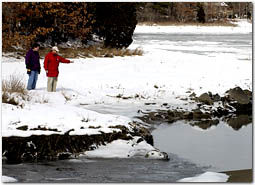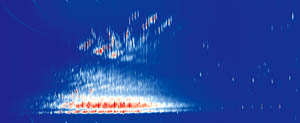 |
Science Highlights > Oil Spill Effects Can Persist for Decades
Oil Spill Effects Can Persist for Decades
 |

Click to enlarge
|
|
WHOI Oceanographer Emeritus George Hampson, right, and Research Associate Bob Nelson revisit the Falmouth, MA Wild Harbor salt marsh most affected by the 1969 oil spill. |
In September 1969, when the oil barge Florida went aground off West Falmouth, Massachusetts, conventional wisdom said the 650,000 liters (169,000 gallons) of diesel fuel spilled into Wild Harbor would disappear after a day or so. Conventional wisdom could not have been more wrong.
More than 30 years after the spill, WHOI Assistant Scientist Chris Reddy and colleagues have shown that, despite the recovery of the marsh in most areas, oil persists in the most heavily oiled area of Wild Harbor’s marshes. Concentrations of some compounds are similar to those observed immediately after the spill and reflect the persistence of No. 2 fuel oil in coastal salt marsh sediments. Animals burrowing into these sediments can be exposed to high levels of some of these compounds, although the long-term biological effects of oil contamination at this site remain unknown. Reddy’s work builds on research by WHOI scientists, begun immediately following the spill and continuing for decades, which showed effects of oil spills could not be dismissed with the disappearance of the visible slick.

Click to enlarge
|
 |
|
This comprehensive two-dimensional gas chromatogram of the most heavily contaminated region of the sediment at Wild Harbor
salt marsh impacted by the 1969 oil spill, shows the distribution of thousands of compounds that compose petroleum. Most of
the oil-type compounds in this sample are still present after 33 years.
|
Important early work by WHOI geochemist Max Blumer checked on the fate of the oil. WHOI biologists Howard Sanders and George Hampson sampled bottom-dwelling organisms, and biologist John Teal studied the oil’s effects on the marsh. Others at WHOI joined the research as months of follow-up extended to years in several locations.
A revisit to Wild Harbor marsh 20 years after the spill, led by WHOI scientists John Teal, John Farrington, and John Stegeman, documented significant quantities of oil buried in marsh sediments at the most heavily oiled location. Nearby animals showed signs of exposure to petroleum chemicals.
Chris Reddy’s work, published in 2002, uses a newly developed chemical technique, comprehensive two-dimensional gas chromatography. This method provides new insight into the oil’s composition and could unlock secrets about why oil compounds persist for years in some locations and not in others. It is the latest addition to decades of scientific effort, which has had significant influence on oil pollution policy and management worldwide.
Chris Reddy’s work was funded by the National Science Foundation and the WHOI Coastal Ocean Institute and Rinehart Coastal Research Center.
|
